The Africa Centre: carefully unchoreographed architecture
London’s newest cultural & community space, The Africa Centre, launches with an exhibition of Sungi Mlengaya’s (Un)Choreographed series of paintings. PATCH Collective members Nyima Murry & Betty Owoo took a tour for recessed.space to see the work, but also the building itself, a tactile and warm refurbishment by Freehaus architects.
From rich and textural dark clay walls, sinuous figures emerge turning,
twisting and posing in Mlengeya’s (Un)Choreographed - their movement
emboldened by the crispness of the negative white space Mlengeya often plays
with within her work. With this new and dynamic show comprising eight
large-scale artworks, Mlengeya is the first artist to occupy the new exhibition
space at the Africa Centre, in Southwark, South London.
A self-taught Tanzanian Artist, Mlengeya is known for working with acrylic in shades of black and brown on perfectly white canvases. Continuing to explore her interest in working with negative space, (Un)Choreographed “pays homage to the vivid history of dance and the myriad of ways that dance creates liberation for women across Africa and its Diaspora.”
![]()
![]()
Her works comfortably fill the space, once just part of a nondescript 1960s office building. Project architects Freehaus have transformed the second floor into the Africa Centre’s impactful exhibition space, and it will host a programme of works by artists from across the African continent and its diaspora, across fine art, sculpture, film, and mixed media.
Maximising the compact floorplan, Freehaus have added panels that can break up the space into smaller sections. Refreshingly, they have not taken a Pawson-esque “white cube” approach, instead choosing to cover the walls and panels in textural Prussian blue clay render and paint. The surprising simplicity and warmth of this decision creates, frames. and holds space for the inherent tension in the paintings’ explosive movement and soft restraint.
![]()
![]()
![]()
This warmth only continues throughout the building, which houses a complex programme of a new pan-African restaurant and bar, areas for co-working, education, and events, as well as the central exhibition space. All are adorned with carefully curated soft furnishings, bespoke furniture and artworks created by artists and craftspeople from the African continent and its diaspora.
Having originally opened in 1964 in Covent Garden, it was crucial for the sixty-year history of the charity and communities it supports to be recognised within this new headquarters. Responding to the brief for their new home to be “unmistakably African”, the refurbishment follows key themes as design departures to reflect shared traditions across the African continent and global diaspora. Expressed thresholds, tactile surfaces, quality of light and practices of reuse and appropriation are themes which recur in all facets of the building’s design.
![]()
![]()
Connecting craftspeople and artists for the creation of bespoke furniture for the space, including chairs, benches, tables and light fittings, therefore goes beyond creating beautiful interiors to also speak of the ambition of the Africa Centre’s work. It speaks of the centre’s ambassadorial role in representing and celebrating pan-African culture on the world stage.
The seamlessness between the key architectural moments (including the insertion of a new large public stair leading up from the main entrance, and terraces that connect both sides of the building with the neighbouring theatre, cafe and bars of Great Suffolk street) and the rich interior detailing is a testament to the fruitful collaboration between Freehaus, interior designer Tola Ojuolape, and the Africa Centre.
![]()
![]()
Freehaus’ ability to transform this originally unremarkable concrete office building into a cultural centre that houses such a wide range of activities on a tight budget is impressive. Whilst each floor serves a different purpose, the building feels well connected as a whole. Supported by the London Mayor’s office through the Good Growth Fund, the Africa Centre was awarded £1.6 million for this first phase of development of the first three floors of the building. Every penny spent has been put to good use, with the building stripped back to its rough concrete frame and built up from there.
Externally, flashes of the bold pink, yellow and green outdoor furniture that can be spotted from the street are the only hint of the colourful interior beyond the newly black painted brick facade. On entering the centre, visitors are bathed in the soft, earthy hues of Clayworks’ natural clay plaster finishes on the walls and structural beams, which are used throughout the building to great effect. Transitioning between a gradient of rosy hues and deep blue, the clay combined with the rough concrete provides a rustic finish comparable to the richness and warmth of adobe, the earthen and organic building material.
![]()
![]()
![]()
Though the main exhibition space is on the second floor, the entire building acts as a gallery in and of itself, with a plethora of donated works adorning the walls in the main rooms and in the circulation spaces. Numerous arched nooks and niches have been carved out to display artefacts from the Africa Centre’s archives: the jewel in the crown being a mural by renowned Mozambican artist and poet Malangatana Ngwenya, painstakingly transferred from the original centre in Covent Garden. It now takes pride of place in the main stairwell of the centre, a testament to the charity’s resilience and tenacity in the face of adversity.
Tatale, a contemporary pan-African restaurant, will be opening in the space later this month, animating the ground floor into the evening. The top two floors remain unprogrammed for the time being, however future aspirations include the creation of a digital learning facility and an incubator for Afro-centric businesses. This forms part of the second phase of the project which is currently seeking funding.
The new Africa Centre is a triumph of African design in a city which so many of the African diaspora call home. Similarly to Yinka Shonibare’s recent renovation of Sketch London, the centre showcases the talent and skill of African designers, artists and makers to a wider audience, and celebrates the richness and diversity of culture from the continent.
![]()
![]()
A self-taught Tanzanian Artist, Mlengeya is known for working with acrylic in shades of black and brown on perfectly white canvases. Continuing to explore her interest in working with negative space, (Un)Choreographed “pays homage to the vivid history of dance and the myriad of ways that dance creates liberation for women across Africa and its Diaspora.”
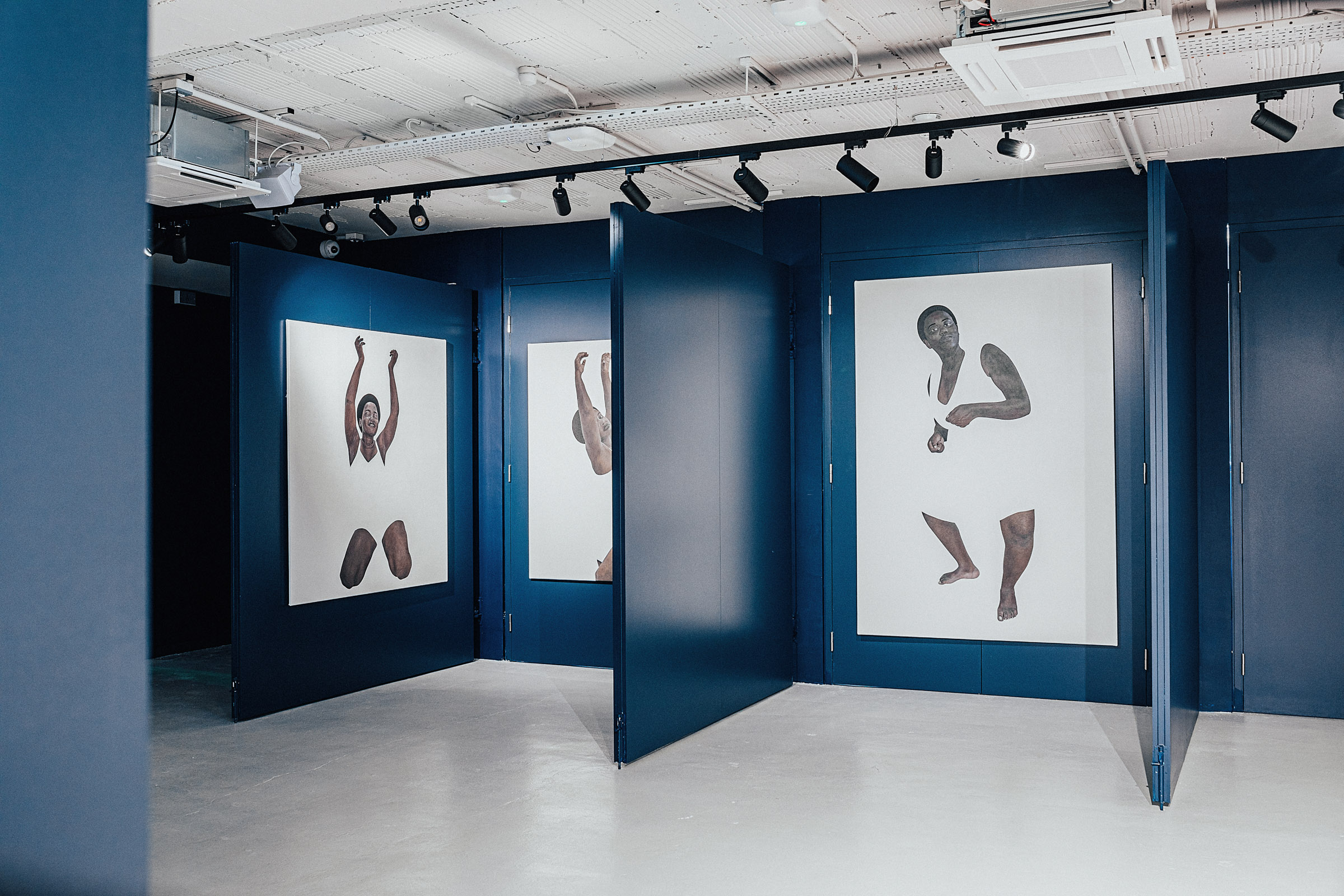

Her works comfortably fill the space, once just part of a nondescript 1960s office building. Project architects Freehaus have transformed the second floor into the Africa Centre’s impactful exhibition space, and it will host a programme of works by artists from across the African continent and its diaspora, across fine art, sculpture, film, and mixed media.
Maximising the compact floorplan, Freehaus have added panels that can break up the space into smaller sections. Refreshingly, they have not taken a Pawson-esque “white cube” approach, instead choosing to cover the walls and panels in textural Prussian blue clay render and paint. The surprising simplicity and warmth of this decision creates, frames. and holds space for the inherent tension in the paintings’ explosive movement and soft restraint.

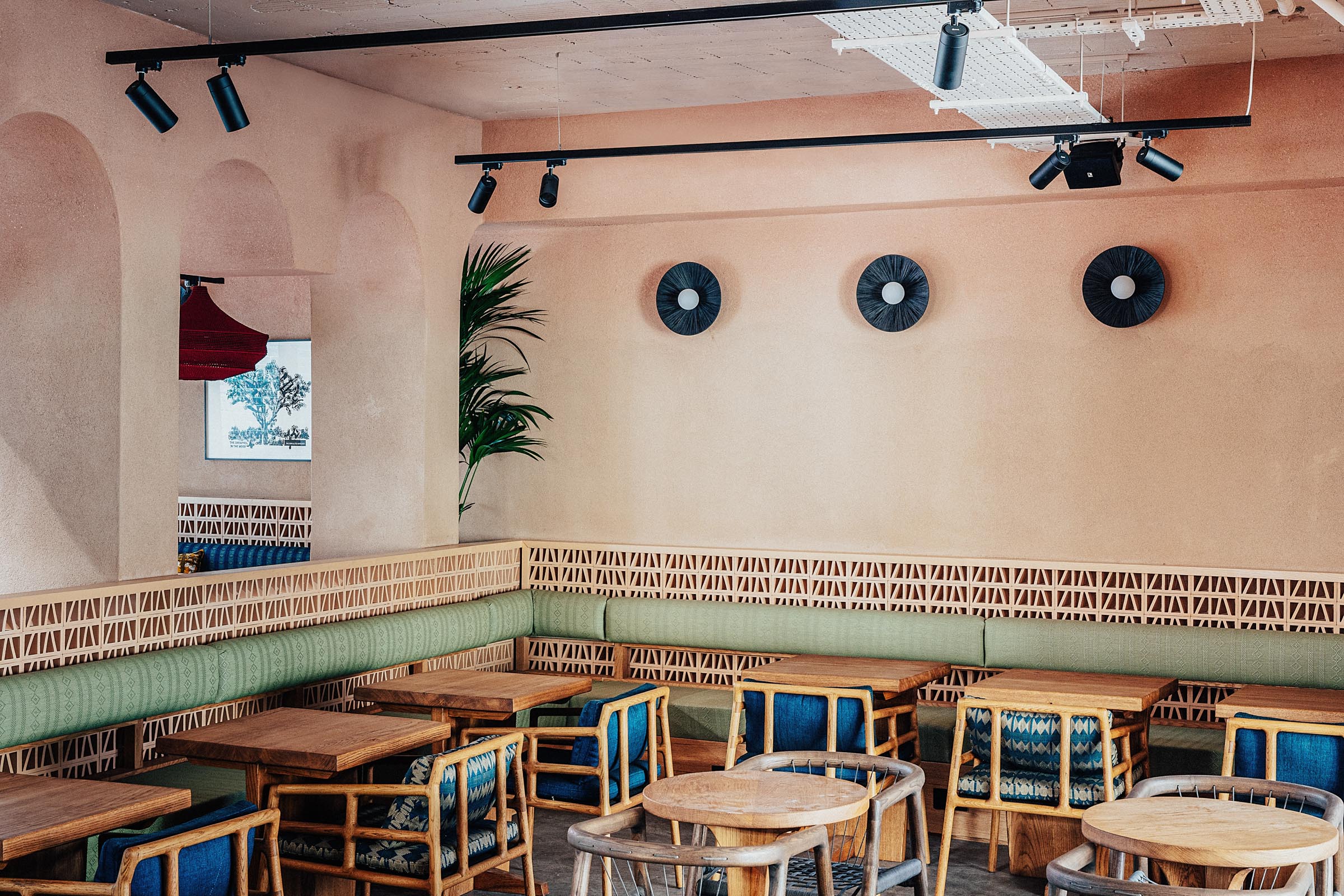

This warmth only continues throughout the building, which houses a complex programme of a new pan-African restaurant and bar, areas for co-working, education, and events, as well as the central exhibition space. All are adorned with carefully curated soft furnishings, bespoke furniture and artworks created by artists and craftspeople from the African continent and its diaspora.
Having originally opened in 1964 in Covent Garden, it was crucial for the sixty-year history of the charity and communities it supports to be recognised within this new headquarters. Responding to the brief for their new home to be “unmistakably African”, the refurbishment follows key themes as design departures to reflect shared traditions across the African continent and global diaspora. Expressed thresholds, tactile surfaces, quality of light and practices of reuse and appropriation are themes which recur in all facets of the building’s design.


Connecting craftspeople and artists for the creation of bespoke furniture for the space, including chairs, benches, tables and light fittings, therefore goes beyond creating beautiful interiors to also speak of the ambition of the Africa Centre’s work. It speaks of the centre’s ambassadorial role in representing and celebrating pan-African culture on the world stage.
The seamlessness between the key architectural moments (including the insertion of a new large public stair leading up from the main entrance, and terraces that connect both sides of the building with the neighbouring theatre, cafe and bars of Great Suffolk street) and the rich interior detailing is a testament to the fruitful collaboration between Freehaus, interior designer Tola Ojuolape, and the Africa Centre.

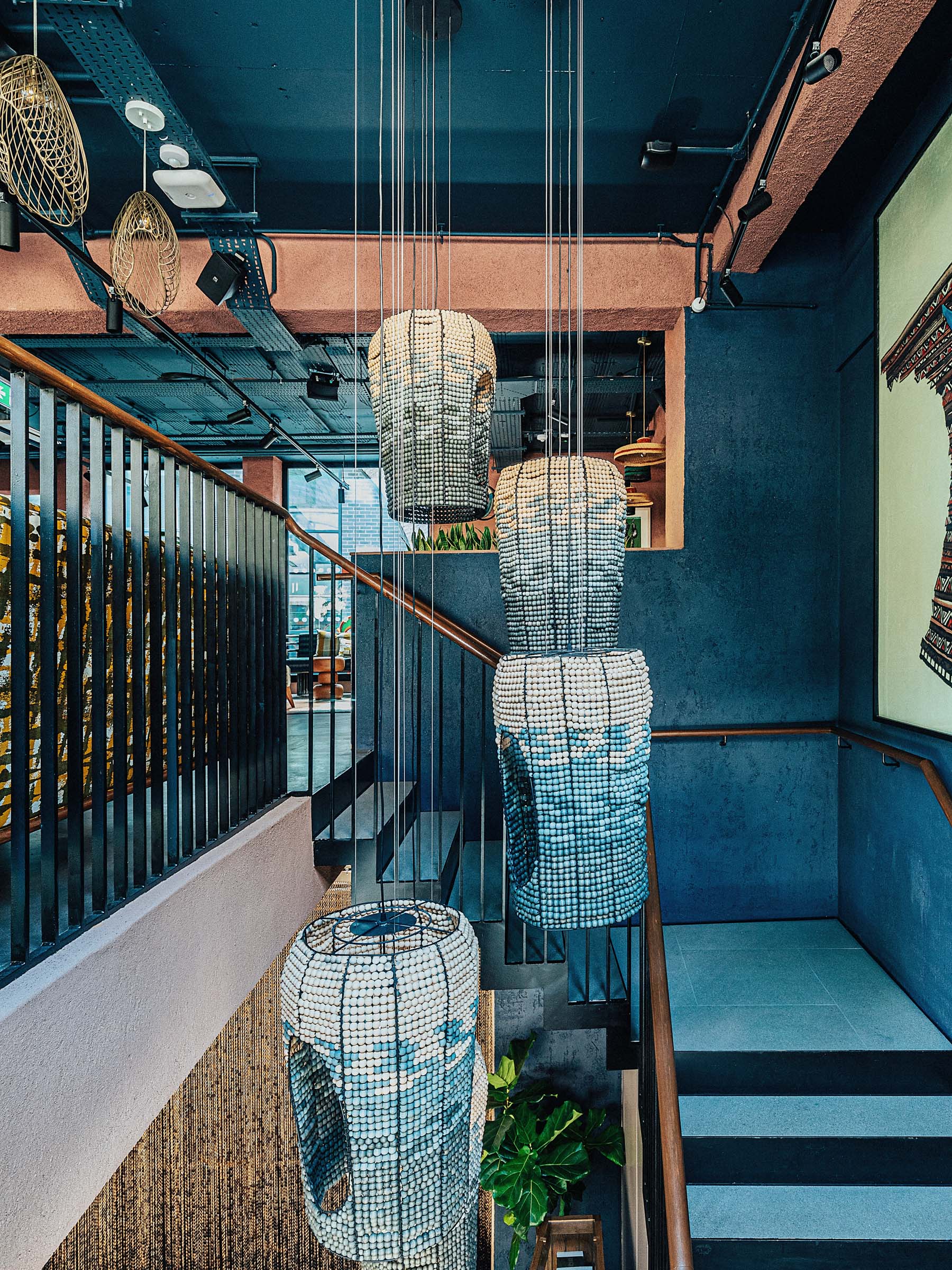
Freehaus’ ability to transform this originally unremarkable concrete office building into a cultural centre that houses such a wide range of activities on a tight budget is impressive. Whilst each floor serves a different purpose, the building feels well connected as a whole. Supported by the London Mayor’s office through the Good Growth Fund, the Africa Centre was awarded £1.6 million for this first phase of development of the first three floors of the building. Every penny spent has been put to good use, with the building stripped back to its rough concrete frame and built up from there.
Externally, flashes of the bold pink, yellow and green outdoor furniture that can be spotted from the street are the only hint of the colourful interior beyond the newly black painted brick facade. On entering the centre, visitors are bathed in the soft, earthy hues of Clayworks’ natural clay plaster finishes on the walls and structural beams, which are used throughout the building to great effect. Transitioning between a gradient of rosy hues and deep blue, the clay combined with the rough concrete provides a rustic finish comparable to the richness and warmth of adobe, the earthen and organic building material.

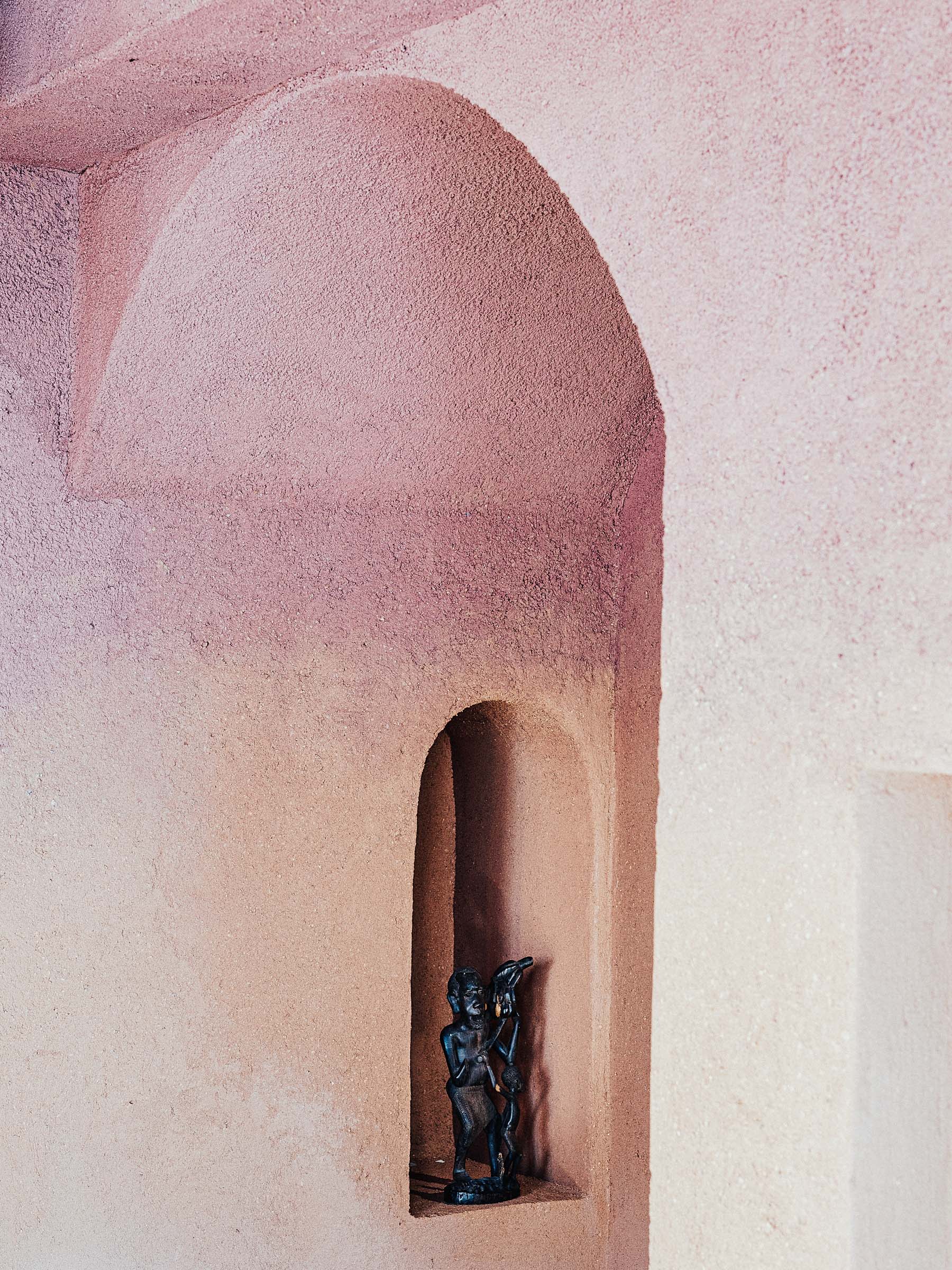

Though the main exhibition space is on the second floor, the entire building acts as a gallery in and of itself, with a plethora of donated works adorning the walls in the main rooms and in the circulation spaces. Numerous arched nooks and niches have been carved out to display artefacts from the Africa Centre’s archives: the jewel in the crown being a mural by renowned Mozambican artist and poet Malangatana Ngwenya, painstakingly transferred from the original centre in Covent Garden. It now takes pride of place in the main stairwell of the centre, a testament to the charity’s resilience and tenacity in the face of adversity.
Tatale, a contemporary pan-African restaurant, will be opening in the space later this month, animating the ground floor into the evening. The top two floors remain unprogrammed for the time being, however future aspirations include the creation of a digital learning facility and an incubator for Afro-centric businesses. This forms part of the second phase of the project which is currently seeking funding.
The new Africa Centre is a triumph of African design in a city which so many of the African diaspora call home. Similarly to Yinka Shonibare’s recent renovation of Sketch London, the centre showcases the talent and skill of African designers, artists and makers to a wider audience, and celebrates the richness and diversity of culture from the continent.
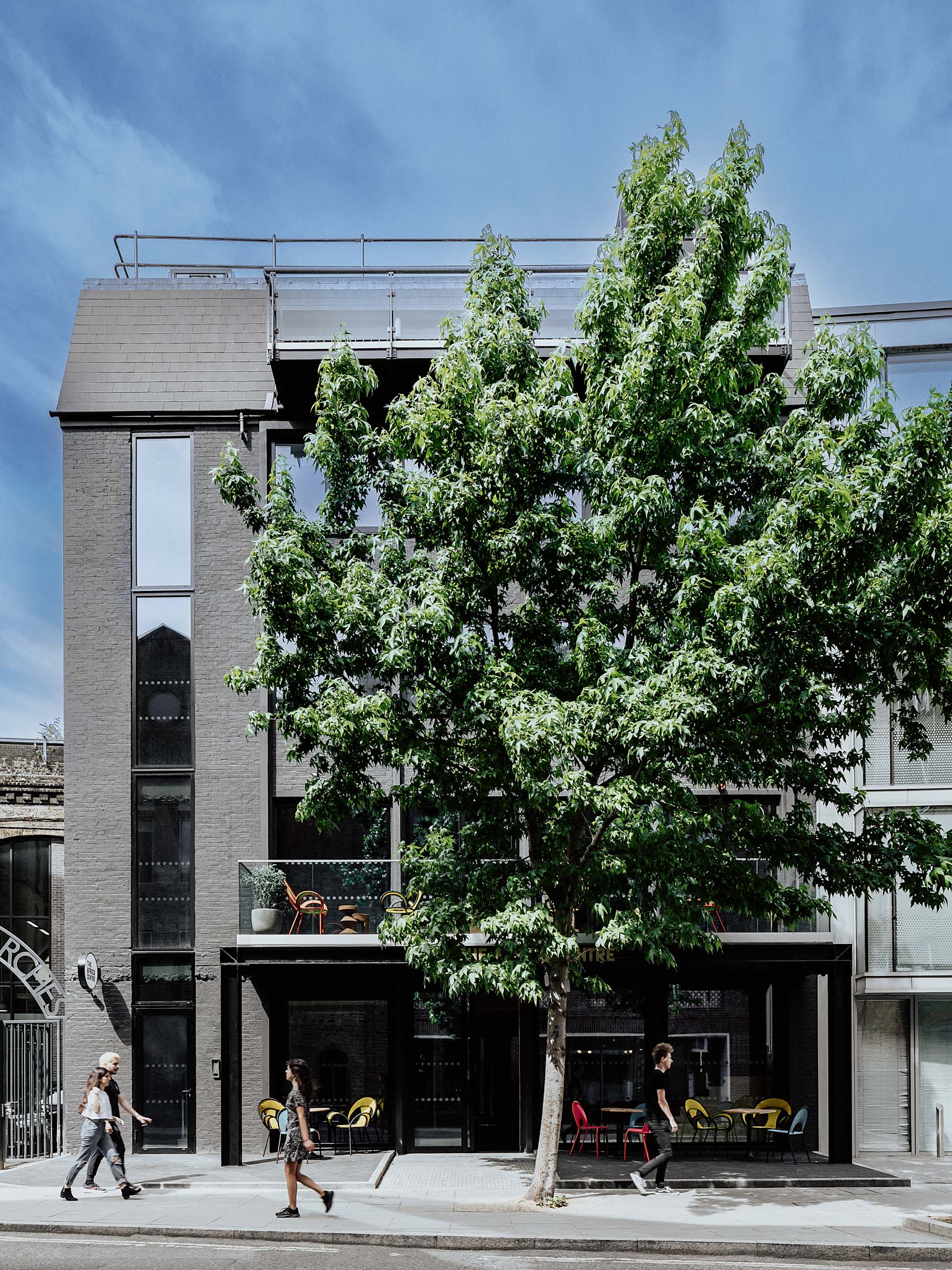

The Africa Centre has a rich legacy stretching over six decades, A cultural hub to celebrate the diversity of Africa and its diaspora, by promoting creativity and innovation in African thought, art, culture, business and entrepreneurship, the centre’s vision is of a contemporary 21st century Africa: vibrant, global and seated at the table.
www.africacentre.org.uk
Freehaus was founded by Tom Bell and Jonathan Hagos, as a diverse yet like-minded studio of architects who make accessible, honest and representative buildings. Freehaus’ designs are anchored to their location, & authentic to both their people & context. The practice’s buildings are made to last: they are clearly configured, & in turn reconfigurable, to extend their social, environmental and heritage value. They are put together with care and economy, & refined through detail & craft.
www.freehausdesign.com
Sungi Mlengeya was born in 1991 in Dar es Salaam, Tanzania. She is a self-taught artist who works primarily in the acrylic medium on canvas creating paintings that are free, minimalist and with a curious use of negative space. Most of the works consist of dark figures in minimal shades of black and browns against perfectly white backgrounds, a commemoration of women who surround her. In 2020, Sungi was honoured in Apollo 40 Under 40 Africa, a selection the most inspirational young people in the African art world.
sungimlengeya.com/
Nyima Murry & Betty Owoo are founding members of PATCH Collective - a multidisciplinary group of POC spatial practitioners born out of the third cohort of New Architecture Writers. Their work centres around creating spatial interventions, designing ephemeral events and curating intimate discussions, all through the lens of being of a diaspora.
www.newarchitecturewriters.org
Nyima Murry is a British-Tibetan architectural designer, curator and filmmaker. She is currently undertaking a Masters in Landscape Architecture at the Bartlett, UCL.
www.instagram.com/nyimamurry
Betty Owoo is a London-based spatial designer, educator and writer. She is currently an architectural designer at Be First London.
www.instagram.com/bettsbubbles
www.freehausdesign.com
Sungi Mlengeya was born in 1991 in Dar es Salaam, Tanzania. She is a self-taught artist who works primarily in the acrylic medium on canvas creating paintings that are free, minimalist and with a curious use of negative space. Most of the works consist of dark figures in minimal shades of black and browns against perfectly white backgrounds, a commemoration of women who surround her. In 2020, Sungi was honoured in Apollo 40 Under 40 Africa, a selection the most inspirational young people in the African art world.
sungimlengeya.com/
Nyima Murry & Betty Owoo are founding members of PATCH Collective - a multidisciplinary group of POC spatial practitioners born out of the third cohort of New Architecture Writers. Their work centres around creating spatial interventions, designing ephemeral events and curating intimate discussions, all through the lens of being of a diaspora.
www.newarchitecturewriters.org
Nyima Murry is a British-Tibetan architectural designer, curator and filmmaker. She is currently undertaking a Masters in Landscape Architecture at the Bartlett, UCL.
www.instagram.com/nyimamurry
Betty Owoo is a London-based spatial designer, educator and writer. She is currently an architectural designer at Be First London.
www.instagram.com/bettsbubbles
www.newarchitecturewriters.org
Nyima Murry is a British-Tibetan architectural designer, curator and filmmaker. She is currently undertaking a Masters in Landscape Architecture at the Bartlett, UCL.
www.instagram.com/nyimamurry
Betty Owoo is a London-based spatial designer, educator and writer. She is currently an architectural designer at Be First London.
www.instagram.com/bettsbubbles
visit
(Un)Choreographed by Sungi Mlengeya is on at The Africa Centre until 24 July 2022.
www.africacentre.org.uk/event/unchreographed-by-sungi-mlengeya
images
All photographs courtesy of The Africa Centre,
© Taran Wilkhu
publication date
05 July 2022
tags
Africa, The Africa Centre, Architecture, Building, Community, Diaspora, Freehaus, Interior, London, Sungi Mlengeya, Nyima Murry, Malangatana Ngwenya, Tola Ojuolape, Betty Owoo
www.africacentre.org.uk/event/unchreographed-by-sungi-mlengeya


